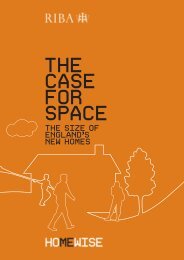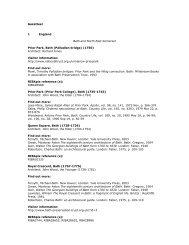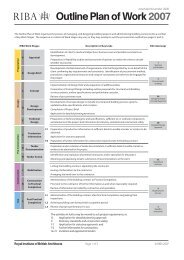Albertopolis Walking Tour: transcript - Royal Institute of British ...
Albertopolis Walking Tour: transcript - Royal Institute of British ...
Albertopolis Walking Tour: transcript - Royal Institute of British ...
You also want an ePaper? Increase the reach of your titles
YUMPU automatically turns print PDFs into web optimized ePapers that Google loves.
around the union, again to a design by Webb, however these have since been considerably<br />
added to, including an additional storey on top.<br />
Continue along Prince Consort Road, pausing at the bottom <strong>of</strong> the steps which lead up to<br />
the Albert Hall. In the centre <strong>of</strong> the steps you’ll see the Memorial to the Great Exhibition<br />
<strong>of</strong> 1851, designed by Joseph Durham, and appropriately topped with a statue <strong>of</strong> Prince<br />
Albert. Now turn around to face the grand red brick building on the other side <strong>of</strong> the road,<br />
the <strong>Royal</strong> College <strong>of</strong> Music.<br />
Pause the recording<br />
13. <strong>Royal</strong> College <strong>of</strong> Music<br />
28.57mins<br />
The <strong>Royal</strong> College <strong>of</strong> Music began its days in<br />
1873 as the National Training School for Music.<br />
Initially it was housed in the building known as<br />
the <strong>Royal</strong> College <strong>of</strong> Organists, which we have<br />
already visited on this walk.<br />
By 1887 the school had changed its name to the<br />
<strong>Royal</strong> College <strong>of</strong> Music and it had outgrown its<br />
premises. The 1851 Commissioners <strong>of</strong>fered<br />
them a new site, first <strong>of</strong> all on the west side <strong>of</strong><br />
Exhibition Road, and later a second site, the one<br />
before you.<br />
This new location was on the south side <strong>of</strong> a<br />
new street, Prince Consort Road, and was<br />
<strong>of</strong>fered with a lease for 999 years. The college<br />
commissioned the experienced architect Sir<br />
Arthur Blomfield to design their new premises,<br />
and he produced a grand, red brick French<br />
baronial style building which was formally<br />
opened by the Prince <strong>of</strong> Wales on 2 May 1894.<br />
<strong>Royal</strong> College <strong>of</strong> Music, 2010<br />
Photographer: Wilson Yau<br />
Blomfield had faced quite a challenge. The site<br />
was north facing, overlooked by the majestic Albert Hall, and at the time two large blocks <strong>of</strong><br />
flats were planned to be built either side. The architect therefore needed to produce<br />
something tall and grand, to compete with its neighbours.<br />
He insisted his design for the main façade must wait until the plan had been completely<br />
decided upon. However, in the end he had to provide a façade for a tall building consisting<br />
mainly <strong>of</strong> small rooms in storeys <strong>of</strong> nearly equal and modest height. The result was a façade<br />
with small-scale subdivisions, and as such it was criticised for its lack <strong>of</strong> monumentality and<br />
interest.<br />
Blomfield faced further disappointment in that he had intended to further develop the<br />
building behind with two quadrangles, but this was put <strong>of</strong>f until later, and ultimately was not<br />
built by Blomfield. The college underwent several extensions in the 1960s, including one to<br />
14










